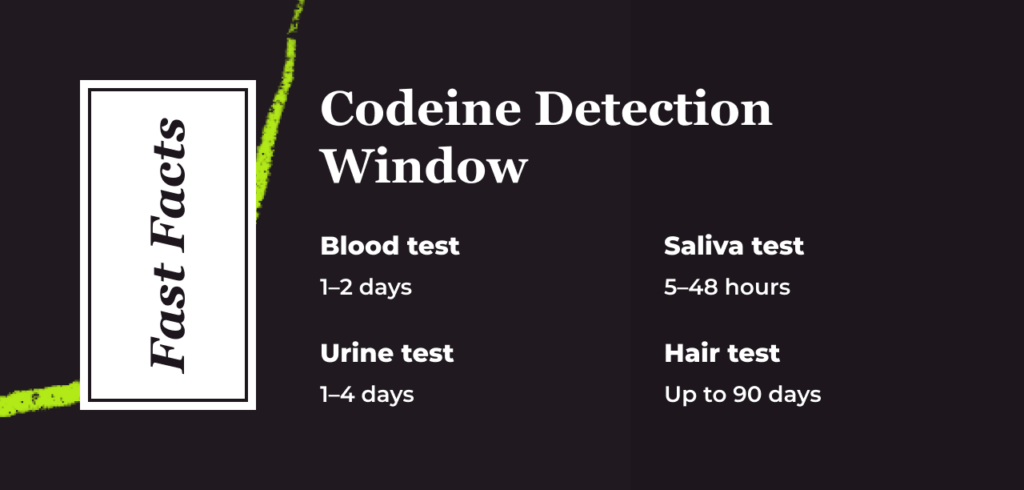Codeine stays in your system for about one day, but it can be detected in a drug test for much longer, depending on the type of drug test.
Codeine is a powerful opioid painkiller, typically prescribed in oral form. Most people notice changes within about 30 minutes, and they may feel altered for up to six hours.
People with opioid use disorder (OUD) may misuse codeine by snorting or injecting it, changing how quickly it works or how long it remains active.
No matter how you take codeine, it can be detected in drug tests for hours — and sometimes even longer. Rather than trying to pass these tests through deception, it’s better to get help for OUD and stop taking the drug altogether.

Estimated Codeine Detection Times
| Drug Test | Detection Time |
| Blood test | 1-2 days |
| Urine test | 1-4 days |
| Saliva test | 5-48 hours |
| Hair test | 90 days or longer |
Duration of Effects of Codeine
When taken orally, codeine starts working within about 15 to 30 minutes, reaching peak efficacy within about an hour. The effects last for up to six hours.[1]
Researchers haven’t studied how long codeine lasts when humans inject or snort it. These studies aren’t easy to conduct, as subjecting people to dangerous techniques can be unethical. Codeine pills are filled with byproducts that can cause serious problems when injected or inhaled.
But in general, people who inhale or inject drugs do so to make them work quicker. And often, they repeat doses to keep a high going. This affects how long codeine stays in the body
What Is Codeine’s Half-Life?
A drug’s half-life represents the time required for a drug’s concentration to lower by 50%.[2] Doctors use this number to understand how quickly the body can excrete common drugs, so they can provide an appropriate medication schedule for their patients.
Researchers say codeine’s half-life is about three hours, which means it takes nearly a day to completely leave a person’s system.[3] As a result, most people who take this drug for pain do so every four hours. This schedule allows them to keep a constant amount of the drug within their bodies, ensuring pain remains under control.
How Long Does Codeine Remain in Your System?
Based on the half-life, codeine stays in your system for about 21 hours to 24 hours. When people research a drug’s half-life, they’re typically concerned with how long the drug will appear in a routine screening—this may be because they engage in codeine misuse or have a codeine addiction. Employers often use these tests to identify impaired workers, and failing such a test could cost someone a job.
Codeine can be detected in the following types of drug tests:[4]
- Blood test: 1–2 days
- Urine test: 1–4 days
- Saliva test: 5–48 hours
- Hair test: 90 days or longer
Some people use hair samples to detect drugs. Your body puts codeine metabolites deep inside your hair shafts, and those can persist almost indefinitely. Most often, hair follicle tests can detect drug use for up to 90 days or longer.
Factors That Impact the Length of Detectability
While most people can expect to fail a codeine drug test if it’s administered within a few days, your results can vary dramatically.
Some factors that affect the detectability of codeine in your system include:
- Length of codeine use
- Kidney or liver functioning
- Urine concentration
- Urine pH levels
- Metabolism
- Age
- Weight
- Gender
People who use codeine for long periods can fail drug tests administered more than one week since last codeine use.[4] The longer you keep using codeine, the longer your body will need to clear all the molecules and produce a clean result.
Researchers say some people clear codeine faster, so they might produce clear results within a few hours. A known genetic variation alters how quickly your body can process and eliminate the drug.[5] If you have it, your results could be unpredictable.
Your age can also play a role in detectability. Healthy organs can process drugs faster than those impaired by disease, an unhealthy lifestyle or age. If your overall health is poor or you’re older, drugs will persist in your body longer.
How Does the Body Metabolize & Break Down Codeine?
Your body pushes codeine through multiple digestive steps, metabolizing it into several different chemicals (such as norcodeine) before rendering it inactive.
About 90% of your codeine dose is excreted by your kidneys.[3]
Each dose you take puts incredible strain on critical organs, and the more damage they endure, the less effective they become. This means that as you misuse codeine for longer, it will begin to take your body longer to process the drug. As a result, codeine will remain in your body for longer over time.

Reviewed By Peter Manza, PhD
Peter Manza, PhD received his BA in Psychology and Biology from the University of Rochester and his PhD in Integrative Neuroscience at Stony Brook University. He is currently working as a research scientist in Washington, DC. His research focuses on the role ... Read More
- Onset, Peak, and Duration of Common Pain Medications. Department of Health and Human Services, Texas. https://www.hhs.texas.gov/sites/default/files/documents/doing-business-with-hhs/provider-portal/QMP/PainMedicationTable.pdf. Accessed March 2023.
- Half Life. StatPearls. https://www.ncbi.nlm.nih.gov/books/NBK554498/. June 2022. Accessed March 2023.
- Codeine. StatPearls. https://www.ncbi.nlm.nih.gov/books/NBK526029/. February 2023. Accessed March 2023.
- Detection Times of Drugs of Abuse in Blood, Urine, and Oral Fluid. Therapeutic Drug Monitoring. https://pubmed.ncbi.nlm.nih.gov/15228165/. April 2004. Accessed March 2023.
- Codeine: Time to Say No. Pediatrics. https://pubmed.ncbi.nlm.nih.gov/27647717/. October 2016. Accessed March 2023.
Download Our Free Program Guide
Learn about our program, its effectiveness and what to expect
Related Content
Imagine what’s possible on the other side of opioid use disorder.
Our science-backed approach boasts 95% of patients reporting no withdrawal symptoms at 7 days. We can help you achieve easier days and a happier future.